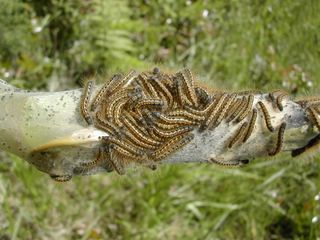
Malacosoma californica
When we finally moved up to Port Townsend last June, we arrived in time to see the damage tent caterpillars (Malacosoma californica) had done to our fruit trees. Even though the previous owners had come by and sprayed pesticides, there was leaf damage. The pesticides had prevented further damage on the fruit trees, but the tents were evident on all the other deciduous trees in the yard. They are incredibly unsightly things. We pruned the branches that had the most infestation. We did not spray any additional pesticides relying on physical removal as the best and least offensive intervention.
On our walk today, we noticed there was an infestation on the Larry Scott Memorial trail that runs along Port Townsend Bay. We photographed the branch tip on one tree.
We did a bit of research on these caterpillars and found the following information from the Washington Toxics Coalition:
"The tent caterpillar is one of the most conspicuous and familiar insect pests in the Northwest. Their silky, white tents can easily be seen covering the tips of tree branches. Tent caterpillars eat the foliage of many deciduous trees and shrubs, especially alder, willow, fruit trees, and roses. During a heavy infestation they will migrate and feed on many other plants.
Tent caterpillars damage plants by eating the foliage as it emerges. A healthy plant will usually grow out new leaves by summer, but its growth may be reduced, making it more susceptible to the stresses of drought, cold, disease, and other insects. For this reason, it is a good idea to monitor tent caterpillars closely and control them if necessary. Fortunately, there are effective non-chemical control methods available.
The two kinds of tent caterpillars that occur in the Northwest are the Forest Tent Caterpillar (Melacoscoma disstria) and the Western Tent Caterpillar (Malacosoma californica). Both are about two inches long when mature, but their body coloration and style of tent construction are different.
In Western Washington, the Western Tent Caterpillar is more frequently seen. It has orange and black markings that run the length of its body. The eggs hatch out in early spring (April or May) when new buds are emerging. The tiny caterpillars immediately begin feeding, and the familiar tents begin to develop on the tips of branches. The caterpillars leave their tent to feed, but return to it at night. When the weather is cool or wet, they tend to be less active and stay closer to the tent. The tent functions to exclude natural enemies, provide shelter from extremes in temperature or humidity, facilitate molting, and aid in colony communication.
Tent caterpillar populations vary greatly from year to year. Severe outbreaks are periodic but do not follow a fixed cyclic pattern. The outbreaks persist for 1 to 4 years before being brought under control by various factors, including disease, parasites, scarcity of food, weather, or a combination of these factors. The population gradually rebuilds when conditions are favorable."
The Washington Toxics Coalition said that physical removal is really a fine way to handle the problem without having to rely on pesticides or chemicals. We were glad to have done an approved method of control.
Do you want to grow your own House Plants, Flowers, Trees and Shrubs for FREE....Grow them to landscape your yard, grow them for fun and for profit....Growing small plants in your backyard is one of the most rewarding things you will ever do in your life. Not to mention the money you can make. Getting started in this home based business is really easy. All you have to do is start rooting cuttings of your favorite plants (I'll show you how to do that), and you are off and running. Any time you have a few extra minutes just stick a few cuttings. Before you know it you will have thousands of plants valued at several thousand dollars.
ReplyDeletehttp://thehomeworkco.com/freeplants.html